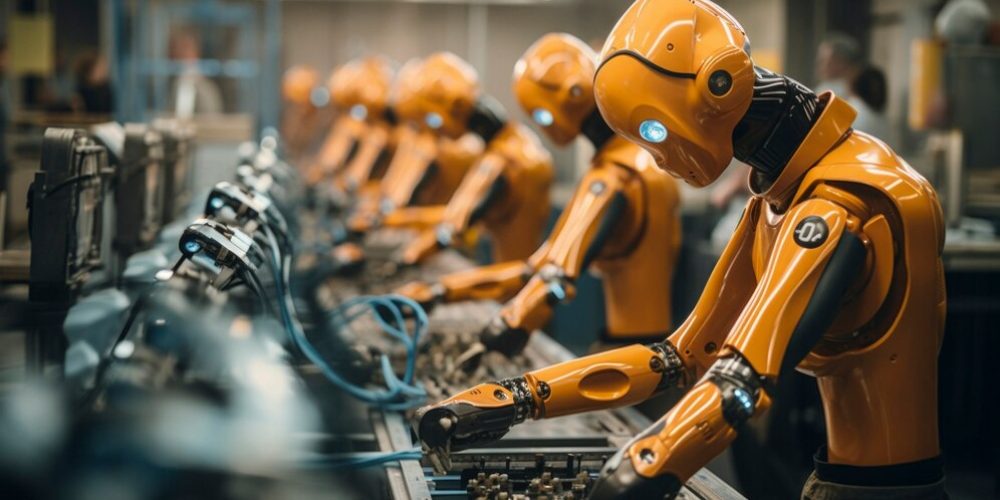Robots have transformed the manufacturing industry by introducing automation, efficiency, and precision to various production processes. The use of robots in manufacturing has grown exponentially over the last few decades due to the numerous advantages they offer. They are used in a wide variety of tasks, from material handling to assembly and inspection. Robots can be programmed to perform repetitive tasks with high accuracy and speed, which can free up human workers for more complex tasks. The use of robots in manufacturing is likely to continue to grow in the future. As robots become more sophisticated and affordable, they will be able to perform an even wider range of tasks. This will lead to even greater benefits for manufacturers, such as increased productivity, improved quality, and reduced costs.
Below, we discuss their role, benefits, challenges, and future trends:
Roles of Robots in Manufacturing
- Assembly: Robots are used to assemble products. This can include tasks such as picking and placing components, fastening parts together, and inspecting products for defects.
- Material handling: Robots are used to move materials around manufacturing plants. This can include tasks such as loading and unloading machines, palletizing products, and transporting materials between different areas of the plant.
- Inspection: Robots are used to inspect products for defects. This can include tasks such as checking for cracks, dents, and other imperfections.
- 3D printing and additive manufacturing: Some robots are capable of 3D printing and additive manufacturing, allowing for the production of complex and customized parts with precision and speed.
- Welding: Robots are used to weld metal parts together. This is a dangerous task that can be performed safely and efficiently by robots.
- Painting: Robots are used to paint products: This can help to ensure a consistent and high-quality finish.
- Data collection and analysis: Robots equipped with sensors can collect data during production, providing valuable insights for process optimization, predictive maintenance, and quality control.
- Customization and small-batch production: Robots enable cost-effective customization and small-batch production, allowing manufacturers to meet customer demands for personalized products.
Different types of robots are as follows:
Assembly Line Robots: These robots perform repetitive tasks such as welding, painting, material handling, and assembling parts. Robots are integrated into lean manufacturing principles to eliminate waste, reduce lead times, and optimize production processes.
Collaborative Robots (Cobots): Designed to work alongside humans, cobots are equipped with sensors and software to ensure the safety of their human coworkers. Cobots are often used for tasks that require close human-robot collaboration, such as precision assembly.
Material Handling Robots: Used for picking, placing, and transporting products or materials.
Inspection Robots: Utilize vision systems and sensors to check for defects or perform quality control.
Packaging Robots: Automate the packaging process, ensuring speed and accuracy.
Cleaning and Maintenance Robots: Perform cleaning tasks or maintenance checks in hazardous environments.
Benefits of using robots in manufacturing are as follows:
Efficiency and Speed: Robots can work 24/7 without breaks, ensuring constant production and faster cycle times. Robots excel at performing repetitive, monotonous tasks with high precision and consistency. They can handle tasks such as welding, painting, assembly, and material handling, reducing human labour and errors. Robots are also designed to be energy-efficient, with features like regenerative braking to reduce power consumption. This contributes to sustainability efforts in manufacturing.
Precision and Accuracy: Robots ensure consistency and reduce human errors in product assembly and quality control. Robots are equipped with sensors and vision systems that can detect defects and inconsistencies in products during the manufacturing process. This helps ensure that only high-quality products are delivered to customers.
Labour Cost Savings: While the initial investment in robots can be substantial, they can lead to long-term cost savings through reduced labour costs, decreased scrap rates, and increased operational efficiency.
Safety and Flexibility: Robots can handle hazardous tasks, reducing the risk of injuries to human workers. Modern robots are designed to be highly flexible and easily reprogrammable. They can quickly switch between tasks and adapt to changes in production requirements, making them versatile assets in dynamic manufacturing environments. Robots can be reprogrammed to perform different tasks, allowing manufacturers to quickly adapt to product changes.
Scalability: Robots enable manufacturers to scale up production without a linear increase in labour. Robots can also be used for inventory management tasks, such as sorting, counting, and tracking products in warehouses and distribution centres. Robots can also be programmed to perform routine equipment inspections and maintenance tasks, helping prevent breakdowns and downtime.
Challenges of using robots in manufacturing are as follows:
High initial costs: Installing robotic systems can be expensive, especially for small and medium-sized manufacturers.
Job displacement: Automation can lead to job losses, especially for low-skilled positions.
Complexity: Setting up and programming robots might require specialized knowledge, adding to training costs.
Maintenance: Robotic systems require regular maintenance, which can be costly and require specialized expertise.

Future Trends
As technology advances, we can expect to see even more collaborative robots working seamlessly alongside human workers. Combining AI with robotics can result in smarter, more adaptive systems that can perform complex tasks and make decisions based on data analysis. As the costs of robotic systems decrease and their ease of use improves, more small and medium-sized manufacturers will adopt robotic solutions. In addition, with advancements in robotics and AI, manufacturers can produce customized products on a larger scale. Augmented Reality (AR) and Virtual Reality (VR) can also be used to assist in robot programming, training, and maintenance.
In conclusion, while robots have brought transformative benefits to the manufacturing industry, their integration must be thoughtfully managed to address challenges and ensure a harmonious balance between human and robotic labour. Robots have revolutionized the manufacturing industry by making it more efficient, flexible, and adaptable to changing market demands. As technology continues to advance, robots are likely to play an even more significant role in the future of manufacturing.


